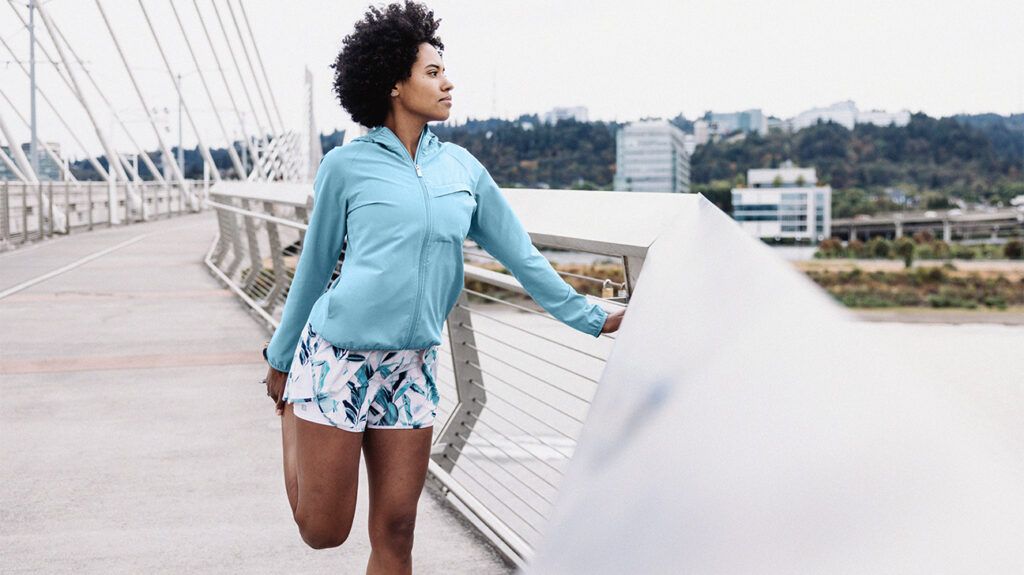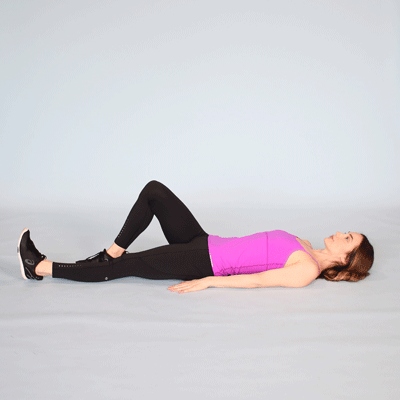Doctors may recommend exercises and stretches to help a person strengthen the muscles around the knee. This can help to support the knees and reduce pain.
People of all ages may experience knee pain. A type of knee pain called patellofemoral pain syndrome, or runner’s knee, is often seen in athletes. In addition to being common in athletic people, knee pain can also be a problem for people who have arthritis.
While it may be tempting to avoid exercise when knee pain occurs, this is not always the appropriate solution. Certain types of exercise can help alleviate existing knee pain and prevent future pain or injury by providing the knee with extra support.
People experiencing knee pain should speak with a healthcare professional before attempting any exercises
This article explains the benefits of strengthening exercises for the knee. It also lists and explains 6 exercises that can help strengthen the knee and alleviate pain.

The Arthritis Foundation states that exercise may be the most effective way to treat osteoarthritis without medication. Strong, flexible muscles can also keep knees healthy and prevent injury.
Knee-strengthening exercises do not directly affect the knee joint. However, they can strengthen the muscles surrounding it. Strong muscles in the legs can help provide support for the knees. This may alleviate pressure and strain on the joints, which can relieve pain and help a person be more active.
Certain exercises can help strengthen the muscles surrounding the knee. If a person experiences pain during these exercises, they should stop doing them and speak to a healthcare professional or physical therapist.
Anyone with severe knee pain should consult a healthcare professional before trying to exercise.
It is a good idea to warm up with light exercise before starting any knee-strengthening exercises. Examples of gentle exercise include walking, cycling, and using an elliptical machine, all of which put minimal stress on the knees.
This type of activity can help increase blood flow to the muscles and allow them to be more flexible.
Muscles involved: Quadriceps (front of the thigh) and abdominal (stomach) muscles.
- Lie down on the floor with the back flat. Use a yoga mat, folded blanket, or exercise mat for comfort on a hard floor.
- Keep the left leg straight and bend the right leg slightly at the knee, bringing the foot closer to the body.
- Pull the abdominal muscles inward by imagining the belly button pulling down toward the floor. Doing this should bring the lower back down against the floor and help provide extra support during the exercise. Place a hand beneath the lower back to make sure that there is no space between the small of the back and the floor. If there is space for the hand, gently push the lower back down on top of the hand.
- Slowly lift the left leg without bending the knee. Keep the toes pointed toward the ceiling and stop when the leg is about 12 inches off the floor. It should not be higher than the bent knee on the right leg.
- Hold the left leg up for a slow count of 5.
- Slowly lower the leg back down to the floor. Do not put it down too quickly or let it drop.
- Repeat two more times with the same leg.
- Switch sides and repeat. Do 2-3 sets with 3 reps for each side.
What not to do
- Do not let the back arch during the exercise.
- Do not jerk or bounce the leg or lift it above the knee on the bent leg.
- People who have osteoporosis or a back compression fracture should not perform this exercise.
Muscles involved: Hamstrings (back of the thigh) and gluteal (buttock) muscles.
- Stand straight with the knees only 1–2 inches apart. Hold on to a stable chair, the countertop, or another object for balance.
- Slowly bend one knee behind the body, lifting the heel off the floor while keeping the thighs aligned. Continue to lift the heel in a smooth motion until the knee bend reaches a 90-degree angle. Keep the straight leg slightly bent to avoid locking it.
- Hold the bent leg up for 5 seconds and then slowly lower it to the floor.
- Repeat two more times with the same leg.
- Switch sides and repeat. Do 3 sets of 10 reps for each side.
What not to do
- Do not point the toes or flex the foot on the lifted leg. Allow the foot to remain in a neutral, flat position.
Muscles involved: Quadriceps
As this exercise gradually becomes easier, a person can increase the resistance by adding an ankle weight. They should begin with a 5 lb weight and gradually increase to a 10 lb weight.
- Using a chair or bench, sit up straight.
- Tighten the thigh muscles.
- Slowly straighten and raise one leg as high as is comfortably possible.
- Squeeze the thigh muscles and hold the position for 5 seconds.
- Lower the foot back to the floor.
- Do 3 sets of 10 for each leg.
What not to do
- Do not swing the leg. Do not use forceful movements to attempt to raise the leg higher.
Muscles involved: Quadriceps, hamstrings, hip flexors, and gluteal muscles.
- Use a large, sturdy stool or exercise platform no taller than 6 inches.
- Step up onto the stool with the right foot and allow the left foot to follow behind. The left foot should not be on the stool but should hang behind it.
- Keep the body weight on the right foot and hold for up to 5 seconds.
- Slowly lower the left foot down and then follow it with the right foot.
- Switch legs, stepping up with the left foot first.
- Repeat, doing 5 reps for each side.
What not to do:
- Do not lock the knees during this exercise. The knees should remain slightly bent.
- Do not allow any part of the stepping foot to hang off the stool or platform.
- People who have issues with balance should not perform this exercise.
Muscles involved: Quadriceps, hamstrings, and gluteal muscles.
- Use a chair on one side, and while standing, place a hand on the chairback for balance.
- Lift right leg about 12 inches from the ground. All weight should be on the left leg.
- Slowly bend down a few inches, pushing weight onto the heel of supporting leg.
- Hold for 3–5 seconds.
- Slowly straighten up.
- Repeat and switch sides.
What not to do:
- Do not lean backward when lifting the leg. Keep the back and upper body straight.
- Do not allow the knee to move forward over the toes in the supporting leg.
Muscles involved: Quadriceps and gluteal muscles.
- Stand with the head, shoulders, back, and hips flat against a wall.
- Step both feet out about 24 inches away from the wall, while keeping the back and shoulders against it. Keep the feet no more than hip width apart.
- Slide the back down the wall slowly until the body is just above a normal sitting position.
- Hold for 5 seconds and then slide back up.
- Repeat.
What not to do:
- Do not squat too low. The knees should not go over the toes.
- Do not use fast, jerky movements. Perform the exercise slowly and smoothly.
After exercising any muscle group, it is important to stretch the muscles. Stretching helps improve flexibility and reduce pain and injury. Post-exercise stretching can also help to improve range of motion and reduce the risk of delayed onset muscle soreness.
Quadricep stretch
- While standing, hold on to the back of a chair or put one hand on a wall for balance, if needed.
- Lift one foot behind the body and grab the ankle with the hand.
- Keep the back straight and the knees close together.
- Pull the heel close to the buttocks without forcing it or causing pain.
- Hold for up to 30 seconds and then slowly lower the leg.
- Switch sides and repeat 2-3 times on each side.
Toe touches
There are many different ways to stretch the hamstrings in the back of the legs. One is through traditional toe touching.
- With the feet close together, slowly bend over at the hips and extend the arms downward. Keep the legs straight, but do not lock the knees.
- Reach the fingers to the top of the toes and hold for 30 seconds.
- Initially, it may not be possible to reach the toes. In this case, try to get the fingers as close as possible to the toes without causing pain.
What not to do:
- Do not use a bouncing motion. Hold the body still.
Standing hamstring stretch
A standing hamstring stretch is also an effective way to stretch the backs of the legs, and it is less strenuous for the lower back than toe touches.
- Stand up straight with the feet no more than shoulder width apart.
- Bend at the hips slightly and extend the right leg out a few inches in front of the body. Allow the left leg to bend slightly.
- While keeping the back straight, slowly bring the chest downward.
- Bend down as far as possible without causing pain. Hold for 30 seconds.
- Slowly bring the leg back toward the body and stand up straight.
- Repeat with the other leg.
Exercise is a noninvasive and healthful way to help with minor knee pain due to overuse, arthritis, or other causes.
Knee-strengthening exercises are an effective way to help prevent injury and keep the legs strong. Stretching can also help keep the muscles flexible, which can prevent or alleviate pain.
People with health conditions should speak with a healthcare professional before beginning any exercise program.

